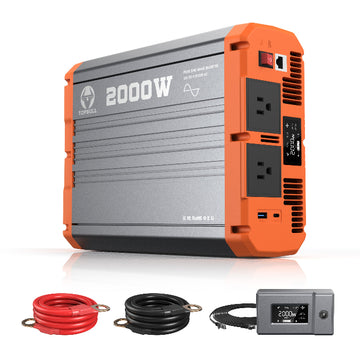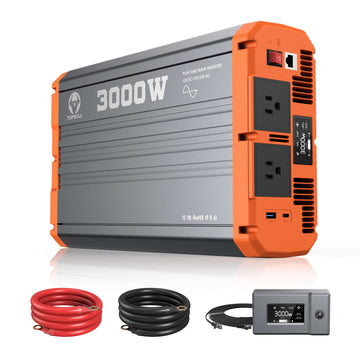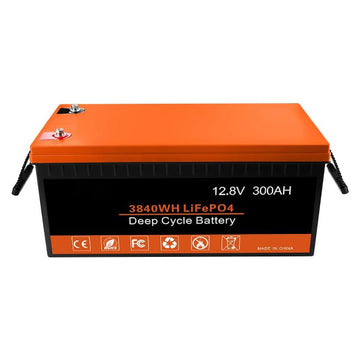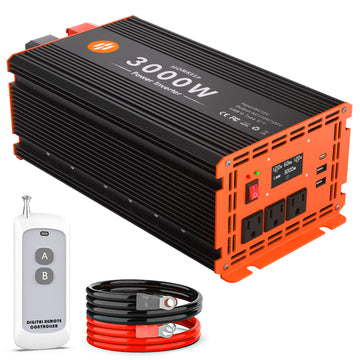Related Reading:
What is an Inverter: Ultimate Guide to Understand Inverters
Understanding DC and AC: Why Conversion Matters
The main difference between AC and DC is that DC flows in only one direction, while AC alternates back and forth, typically in a sine wave pattern. AC power is the standard for mains electricity because it can be transmitted efficiently over long distances using transformers to step up and step down voltage as needed.
DC power is commonly supplied by batteries, solar panels, and rectifiers, making it essential for portable electronics and off-grid power systems. Many household appliances require AC power, but devices like laptops and phones use built-in converters (rectifiers) to convert AC to DC.
While electronic circuits typically rely on DC power, many motors in household appliances run on AC. Some specialized motors, like brushless DC motors, operate on DC. If you're using solar panels, RV batteries, or other DC sources, an inverter is essential for converting DC to AC, ensuring compatibility with standard appliances when off-grid.
How Does a DC to AC Power Inverter Work

Now, let's break down the key components of an inverter:
Battery Pack
The battery serves as the primary energy source in an inverter system. There are two main types:
-
Lead-acid batteries are more affordable but require regular maintenance.
- Lithium batteries offer higher efficiency, longer lifespan, and faster charging.Most inverter-compatible batteries operate at 12V, with capacity measured in ampere-hours (Ah)—which determines how long the inverter can run.
Transformer
This component plays a crucial role in converting the pulsed DC signal generated by the inverter circuit into a stable high-voltage AC output (such as 110V or 220V).
- Iron-core transformers are durable but bulky, and commonly used in low-frequency inverters.
- High-frequency transformers are more efficient and compact, making them ideal for modern inverters.
Control Circuit
This system manages inverter operations and ensures stable performance.
- A PWM (Pulse Width Modulation) controller regulates the output waveform for clean and stable power.
-
Built-in protection mechanisms prevent overload and overheating.
- LCD/LED displays provide real-time monitoring of battery levels, voltage status, and fault conditions.
Below are the steps an inverter follows to achieve conversion. If you find your inverter failing sometimes, here are the possible fixes for a failure in such a scenario.
Step 1: The inverter receives direct current (DC) power from a battery, which stores energy collected from a solar panel (PV cell) or another DC power source.
Step 2: The inverter uses power transistors (MOSFETs or IGBTs) to rapidly switch DC on and off, creating a high-frequency pulse train. This simulates the behavior of an AC signal.
- The waveform can be modified sine wave (simplified approximation) or pure sine wave (clean and smooth like utility power).
- PWM (Pulse Width Modulation) is often used to refine the waveform for efficiency and stability.
Step 3: The inverter passes the pulsed signal through a transformer, which steps up the voltage from 12V DC (or another input level) to around 120V AC to match household appliance requirements.
Step 4: A filtering circuit (capacitors & inductors) smooths out high-frequency noise and distortion, ensuring that the final output is a stable and clean AC waveform suitable for powering electronics and appliances.
Different Types of 12V to 120V Inverters
While all inverters serve the same fundamental purpose—converting DC to AC—there are key differences in their design and performance. Here's a breakdown of the two main types.
Pure sine wave inverters
These inverters produce a smooth and consistent sine wave output, making them ideal for sensitive electronics such as medical devices, high-end audio systems, and appliances with variable-speed motors. They offer higher efficiency, minimal harmonic distortion, and improved energy utilization, ultimately extending the lifespan of connected devices. While more expensive, they ensure stable and reliable power, similar to utility-supplied electricity.
Modified sine wave inverters
Instead of a smooth sine wave, these inverters generate a stepped approximation by combining square waves. They are more affordable and work well for basic appliances like lights, fans, and some power tools. However, they may cause interference, buzzing noise, or reduced efficiency in sensitive devices such as microwaves, refrigerators, and motor-driven equipment. Long-term use may even damage certain electronics due to voltage fluctuations.
|
Feature
|
Pure Sine Wave Inverter | Modified Sine Wave Inverter |
| Waveform | Smooth, consistent sine wave | Stepped, approximated sine wave |
| Best For | Sensitive electronics, medical devices, high-end audio, refrigerators, microwaves, power tools | Basic appliances like lights, fans, and some power tools |
| Efficiency | High efficiency, optimal energy utilization | Lower efficiency, some energy loss |
| Device Compatibility | Works with all AC-powered devices | May cause malfunctions in sensitive electronics |
| Interference & Noise | No interference, silent operation | May cause buzzing noise and interference |
| Heat Generation | Minimal heat, better for long-term use | Generates more heat, reducing efficiency |
Learn more :the difference between pure sine wave and modified wave inverters
Applications of 12V to 110/120V Inverters

Here, we'll go over the various application scenarios of 12V to 120V inverters. As you might have already figured, the use cases are wide and varied. Here are some of them:
-
Home Backup Power: Keeps essential appliances like TVs, fans, and refrigerators running during outages.
-
Vehicle Power Supply: Enables car refrigerators, laptops, and chargers to function while on the move.
-
Outdoor Activities: Power lighting, audio equipment, and small appliances for camping, picnics, and photography.
-
Solar Power Integration: Converts battery-stored solar-generated DC power into usable AC electricity for daily appliances.
- Worksites & Construction: Provides electricity for hand tools and portable equipment in off-grid locations.
How to Choose the Right 12V to 120V Inverter
Not all inverters are the same, so you need to at least take the 4 factors above when picking a power inverter:
-
Define Your Use Case: Determine whether you need it for home backup, outdoor activities, or vehicle use. Different use cases decide the wattage of a power inverter as it should cover the total power requirement of your appliances.
-
Check Power Rating: Ensure the inverter's continuous and peak power output meets your device's requirements.
-
Assess Features & Design: Consider size, number of output ports, remote control, and display options.
- Set a Budget: Compare models within your price range while ensuring good value for money.
Top Picks: Best 12V to 120V Inverters for Your Needs
If you've made it this far, you're probably considering buying a 12V to 120V inverter. Thankfully, TOPBULL inverters ensure that all your requirements are taken care of. There are three main offerings from the brand when it comes to this product category.
-
TOPBULL 2000W Pure Sine Wave Inverter: Ideal for vehicles, homes, RVs, trucks, and off-grid solar systems, delivering stable power for essential appliances.
-
TOPBULL 3000W Pure Sine Wave Inverter (6000W Peak): A powerful choice for RVs, solar setups, and heavy-duty equipment, ensuring smooth and efficient energy conversion.
- TOPBULL 4000W Pure Sine Wave Inverter (8000 Peak): Equipped with a remote controller, perfect for high-power applications and food trucks.
All models feature a 7-step protection system, safeguarding against overload, overvoltage, undervoltage, high temperature, short circuits, leakage, and reverse polarity issues. With high conversion efficiency, stable output voltage, and ultra-quiet operation, these inverters provide seamless, safe, and reliable power for any situation.
Final Words
You should have a clear understanding of how DC is converted to AC using an inverter. Selecting the right inverter requires considering factors like your specific needs, reliability, and performance. No matter your power requirements, TOPBULL offers a range of high-quality pure and modified sine wave inverters to suit various applications. Explore your options today and experience a seamless power solution!













